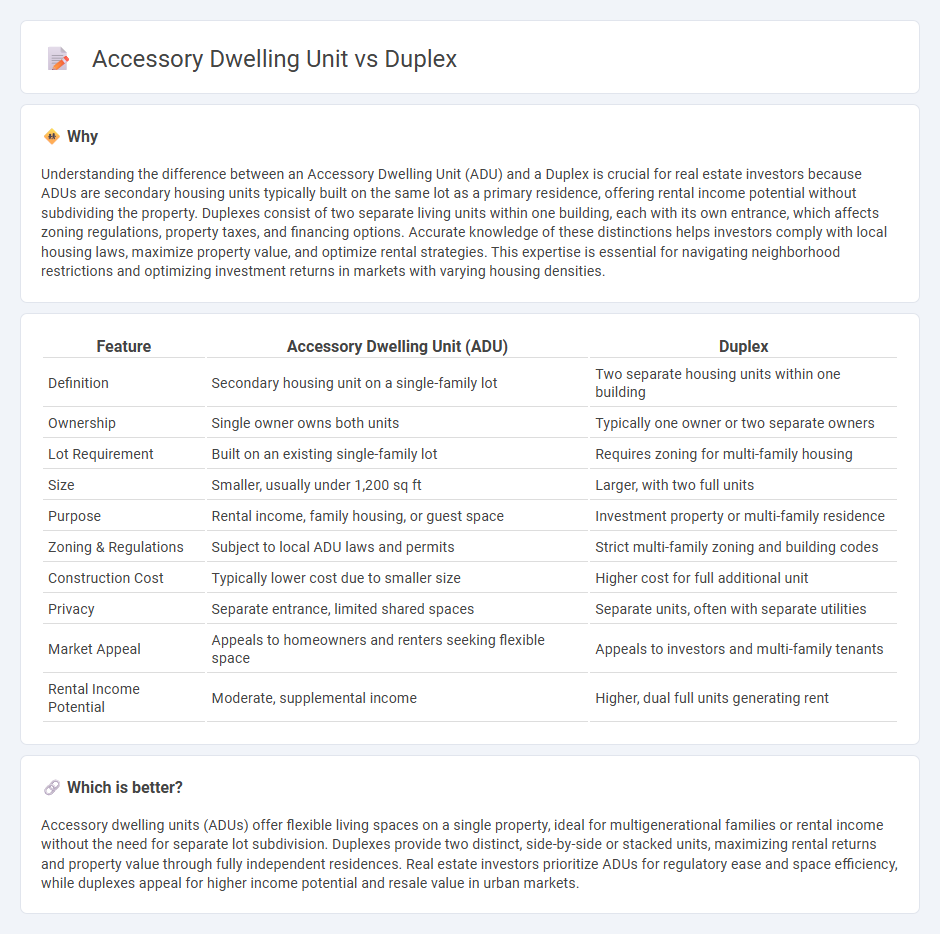
Accessory dwelling units (ADUs) are secondary housing units on a single-family lot, often used for additional rental income or multi-generational living. Duplexes consist of two separate living units within one building, providing distinct residences that share a common wall or floor. Explore the benefits and differences of ADUs and duplexes to determine the best fit for your real estate investment.
Why it is important
Understanding the difference between an Accessory Dwelling Unit (ADU) and a Duplex is crucial for real estate investors because ADUs are secondary housing units typically built on the same lot as a primary residence, offering rental income potential without subdividing the property. Duplexes consist of two separate living units within one building, each with its own entrance, which affects zoning regulations, property taxes, and financing options. Accurate knowledge of these distinctions helps investors comply with local housing laws, maximize property value, and optimize rental strategies. This expertise is essential for navigating neighborhood restrictions and optimizing investment returns in markets with varying housing densities.
Comparison Table
| Feature | Accessory Dwelling Unit (ADU) | Duplex |
|---|---|---|
| Definition | Secondary housing unit on a single-family lot | Two separate housing units within one building |
| Ownership | Single owner owns both units | Typically one owner or two separate owners |
| Lot Requirement | Built on an existing single-family lot | Requires zoning for multi-family housing |
| Size | Smaller, usually under 1,200 sq ft | Larger, with two full units |
| Purpose | Rental income, family housing, or guest space | Investment property or multi-family residence |
| Zoning & Regulations | Subject to local ADU laws and permits | Strict multi-family zoning and building codes |
| Construction Cost | Typically lower cost due to smaller size | Higher cost for full additional unit |
| Privacy | Separate entrance, limited shared spaces | Separate units, often with separate utilities |
| Market Appeal | Appeals to homeowners and renters seeking flexible space | Appeals to investors and multi-family tenants |
| Rental Income Potential | Moderate, supplemental income | Higher, dual full units generating rent |
Which is better?
Accessory dwelling units (ADUs) offer flexible living spaces on a single property, ideal for multigenerational families or rental income without the need for separate lot subdivision. Duplexes provide two distinct, side-by-side or stacked units, maximizing rental returns and property value through fully independent residences. Real estate investors prioritize ADUs for regulatory ease and space efficiency, while duplexes appeal for higher income potential and resale value in urban markets.
Connection
Accessory dwelling units (ADUs) and duplexes both maximize residential property use by providing additional living spaces on a single lot. ADUs are typically smaller, secondary units such as converted garages or basement apartments, while duplexes are designed as two separate but attached housing units under one roof. Both structures increase housing density and offer alternative rental opportunities, making them valuable solutions in urban real estate markets.
Key Terms
Zoning
Zoning regulations often distinguish duplexes as two separate dwelling units sharing a single lot, typically requiring specific lot sizes and frontage to maintain neighborhood density standards. Accessory Dwelling Units (ADUs) are secondary units on the same lot as a primary residence, often allowed under more flexible zoning to promote affordable housing and optimize land use. Explore detailed zoning codes and regional policies to understand the implications for property development and compliance.
Occupancy
Duplexes typically consist of two units designed for separate households, often with shared walls but independent entrances, supporting dual occupancy under one property. Accessory dwelling units (ADUs) are secondary housing units on the same lot as a primary residence, intended to provide additional living space while maintaining the primary home's occupancy status. Explore more to understand how occupancy regulations impact housing options and neighborhood dynamics.
Ownership
Duplex ownership typically involves a single owner holding the entire property, allowing for rental income or family use under one title. Accessory dwelling units (ADUs) are secondary housing units on the same lot as a primary residence but usually share ownership with the main property owner. Explore detailed comparisons to understand how ownership structures impact investment and usage options.
Source and External Links
Duplex Conversion Laws and Regulations In Denver, CO - Provides information on the legal and regulatory aspects of converting a single-family home into a duplex in Denver, including zoning codes and rezoning processes.
Multi-Family Homes & Duplexes for Sale in Denver, CO - Lists various duplexes and multi-family homes available for purchase in Denver, highlighting their features and prices.
Duplex for Rent - Denver, CO - Offers a selection of duplex rentals in Denver, with options to filter by price, bedrooms, and amenities.
 dowidth.com
dowidth.com